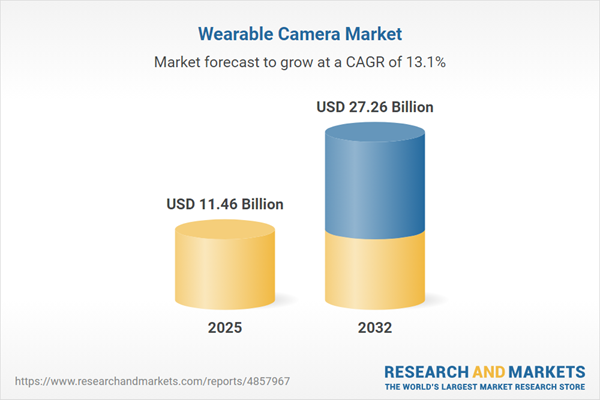Speak directly to the analyst to clarify any post sales queries you may have.
The wearable camera market is emerging as a pivotal tool for senior leadership, enabling digital innovation, real-time oversight, and the ability to address increasingly complex compliance and transparency demands. Forward-thinking organizations are strategically integrating wearable camera technologies to foster adaptive management in competitive environments.
Wearable Camera Market Snapshot
In 2024, the global wearable camera market reached a valuation of USD 10.15 billion, supported by a compound annual growth rate of 13.14%. Enterprises are embracing these solutions to enhance performance and sustain their competitive edge. Increasing miniaturization and modular architecture are resulting in compact, durable devices engineered for rigorous operational settings. The integration of artificial intelligence (AI) analytics increases the value of captured content, providing instant data insights. Adoption across sports, manufacturing, and security is widespread, underscoring a focus on reliability, responsive documentation, and precise monitoring. Senior decision-makers are embedding wearable camera market solutions within broader digital frameworks, streamlining compliance and building the agility needed for rapidly evolving regulatory landscapes.
Scope & Segmentation of the Wearable Camera Market
- Product Types: Action cameras are tailored for high-mobility environments including sports and automotive operations, enabling dynamic, versatile video capture. Body-worn cameras deliver documentation and visibility for law enforcement and corporate users, supporting compliance and operational transparency. Helmet cameras contribute to safety tracking and performance analysis in both industrial and recreational settings.
- Price Ranges: Basic units offer fundamental recording functions suited for routine business settings; mid-tier devices provide expanded monitoring for extended workflows; premium solutions incorporate advanced imaging and analytics suited to compliance monitoring and senior-level oversight.
- Resolution Standards: Organizations choose from HD, Full HD, 4K, and 8K cameras, aligning image quality with analytical objectives and balancing clarity with manageable data processing.
- Distribution Channels: Companies access wearable camera market products through electronics outlets, technology-focused specialists, or digital marketplaces. Each procurement path is suited to differing needs for volume, customization, and after-sales support.
- Applications: Wearable cameras serve telemedicine and remote healthcare by enabling live video collaboration. Media production teams improve workflows with hands-free recording, while sectors such as retail and law enforcement leverage these tools to support compliance and auditability. Sports organizations use analytics from wearable feeds for enhanced coaching and detailed performance reviews.
- Regional Insights: North America and Western Europe exhibit mature adoption rates due to advanced digital infrastructure and regulatory requirements. East Asia and the Middle East are experiencing fast growth, driven by investments in digitalization and quick adoption of advanced camera systems.
- Company Coverage: Market leaders including Arashi Vision Inc., Axis Communications AB, Axon Enterprise, Drif Innovation Ltd., Garmin Ltd., OMNIVISION Technologies, Panasonic Holdings, and Sony Corporation provide a broad range of solutions. This diversity supports constant innovation and ensures resilient supply chains for enterprise clients worldwide.
Key Takeaways for Senior Decision-Makers
- Modular hardware and software integration streamline wearable camera adoption, allowing seamless alignment with existing IT infrastructure and scalable operations.
- AI-powered imaging and analytics provide timely, actionable intelligence, enabling organizations to adapt quickly to operational changes and enhance compliance responses.
- Active collaboration with both manufacturers and end users is driving ongoing improvements in regulatory compliance and risk management—crucial in sectors under frequent oversight change.
- Standardized analytical environments improve consistency and efficiency of data review, strengthening organization-wide decision-making processes.
- Comprehensive technical support equips enterprises to respond rapidly to operational disruptions and shifts in the regulatory landscape, sustaining business continuity.
- Upgradeable, modular equipment ensures readiness for new compliance norms and extends asset life, without requiring disruptive system overhauls.
Tariff Impact & Supply Chain Strategies
Enterprises are responding to evolving US tariff regulations by redefining procurement approaches and logistics for wearable camera systems. Strengthening partnerships with regional distributors is building greater resilience across global supply chains and supporting compliance with new trade requirements. The deployment of modular technology platforms further protects organizations, maintaining operational velocity and adaptability in a fluid international trade environment.
Methodology & Data Sources
This analysis is based on secondary research, regulatory evaluations, and executive interviews with leading manufacturers and distributors. Each insight has been validated by expert reviewers to ensure relevance for enterprise-level planning and strategic decision-making.
Why This Wearable Camera Market Report Matters
- Senior executives access actionable insights into technological trends, segmentation, and regional opportunities, supporting informed investment and resource planning.
- The report offers targeted guidance to overcome supply chain and regulatory challenges, enabling strategic expansion into new verticals and international markets.
- It provides valuable input for digital transformation projects, simplifying integration and enabling organizations to stay agile as compliance demands shift.
Conclusion
The wearable camera market is helping organizations sharpen real-time decision-making and reinforce operational resilience. This report gives business leaders practical insights to drive ongoing innovation and proactively maintain a leadership position in competitive environments.
Additional Product Information:
- Purchase of this report includes 1 year online access with quarterly updates.
- This report can be updated on request. Please contact our Customer Experience team using the Ask a Question widget on our website.
Table of Contents
3. Executive Summary
4. Market Overview
7. Cumulative Impact of Artificial Intelligence 2025
List of Figures
Companies Mentioned
The companies profiled in this Wearable Camera market report include:- Arashi Vision Inc.
- Axis Communications AB
- Axon Enterprise, Inc.
- Brinno Incorporated
- Digital Ally Inc.
- Drift Innovation Ltd.
- Garmin Ltd.
- OMNIVISION Technologies, Inc.
- Panasonic Holdings Corporation
- Sony Corporation
Table Information
| Report Attribute | Details |
|---|---|
| No. of Pages | 199 |
| Published | November 2025 |
| Forecast Period | 2025 - 2032 |
| Estimated Market Value ( USD | $ 11.46 Billion |
| Forecasted Market Value ( USD | $ 27.26 Billion |
| Compound Annual Growth Rate | 13.1% |
| Regions Covered | Global |
| No. of Companies Mentioned | 11 |









